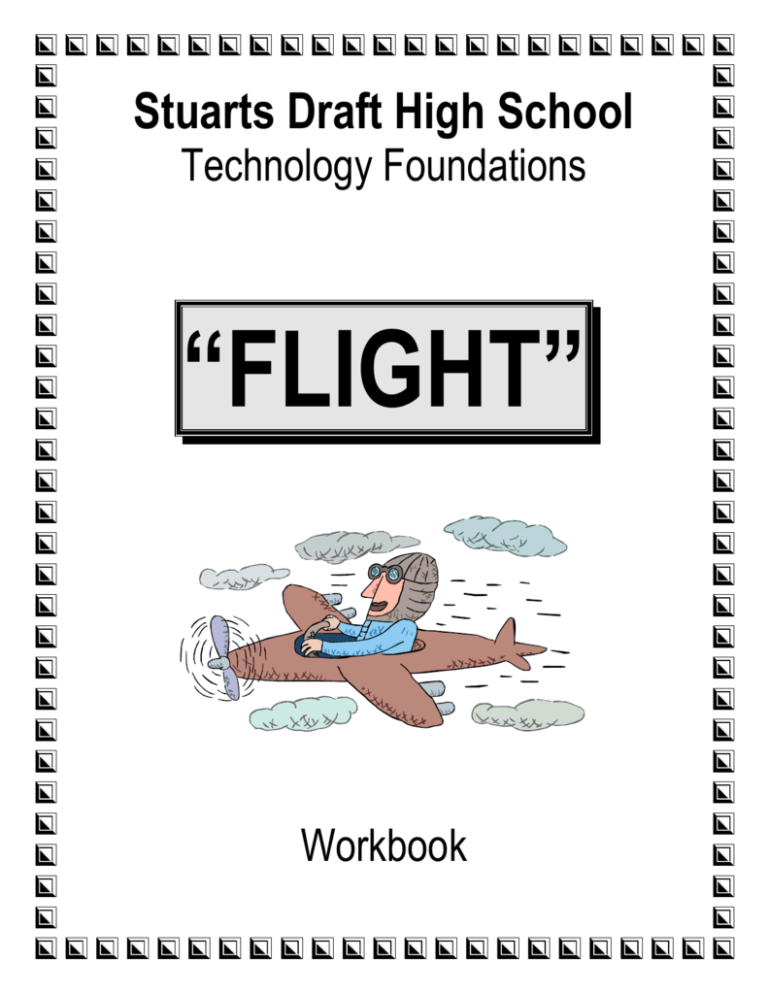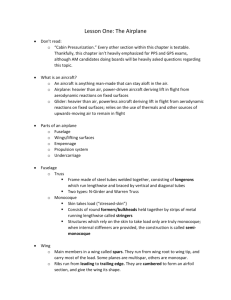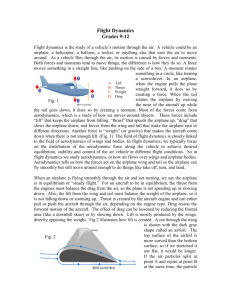Technology Foundations
advertisement

Stuarts Draft High School Technology Foundations “FLIGHT” Workbook Trim Action For an aircraft to remain aloft, the lift from the wings must counter the downward pull of gravity. The Sum of the lift that develops over the wings can be considered to act at a single point along the fuselage called the center of lift (CL) position. Likewise the weight of an aircraft can be considered to act through a single point called the center o gravity (CG) position. When the center or lift from the wings aligns with the center of gravity of weight, and the forces balance, level flight can be maintained. Neutral Balance The horizontal stabilizer in the tail functions to hold an aircraft stable at a given pitch so that the wings maintain the correct amount of lift and do not stall. If an air disturbance causes an aircraft to pitch up or down, it will change the angle of attack (AOA) of the wings and tail and cause a lifting force to develop in the tail that will act against any pitch change. This tail force will remain as long as the aircraft is rotated out of position. As the restoring actions in the tail rotate the aircraft back to proper pitch, the restoring forces in the tall will diminish and disappear. Unstable Balance If a plane is properly balanced, the center of gravity (CO) may end up being behind the center of lift (CL). In order for an aircraft to balance and fly' when this happens the horizontal stabilizer must also be positioned to develop lift. With this balance or forces the aircraft is much less able to keep itself stable and level in air turbulence because the restoring action of the tall will be canceled by the changes in the lever action of lift in the wings as the pitch changes. Stable Balance In most gliders and airplanes, the center of gravity is kept positioned forward of the center of lift of the wing to ensure the aircraft remains stable. In this configuration a downward lift force is needed in the tail to balance the forces. The horizontal stabilizer is given an angle of attack that develops a downward force that balances the aircraft for flight. This is called trimming an aircraft. Flight Vocabulary Terms Aerodynamics The study of the forces acting upon an object in motion through an atmosphere. Aileron A movable hinged section on the trailing edge of an airplane's wing used to control rolling movement. Airfoil The cross-section shape of a wing taken at right angles to the wingspan. Airship A self-propelled, lighter-than-air craft, which can be steered. Airspeed The speed of an aircraft relative to the air rather than to the ground. Altimeter A device for measuring the relative altitude of an aircraft by measuring atmospheric pressure. Angle of Attack The angle at which a wing strikes the air stream. Angle of Incidence The angle of the wing in relation to an arbitrary line fore and aft in the fuselage. Aspect Ratio The relationship of the wingspan to the wing chord, expressed numerically by the number of times the span can be divided by the chord. Autogiro An airplane which flies by virtue of freewheeling rotating wings set windmill fashion above the fuselage Bank A turn made in flight with one wing tip lower than the other. Camber The curvature of the wing from the leading edge to the trailing edge. Canard An airplane designed to fly tail first. Center of Gravity Center of Lift Center of Pressure The point through which the resultant forces of gravity act no matter how the body is oriented. The point at which the average of all lifting forces act. The intersection of the resultant force with the plane of the chord of the lower surface. This center varies with the angle of incidence in a characteristic manner for every wing shape. The center is located for a given angle of incidence by giving its distance from the leading edge in percent of the chord length. Chord The width of a wing from leading edge to trailing edge. Decalage The difference between the angles of incidence of the wing and the stabilizer. Dihedral The up tilt of wing panels toward the tips to increase stability in the roll axis. Elevator The hinged control section of the stabilizer used to induce a change in pitch. Fin The fixed forward portion of the vertical tail. Fixture A form for holding parts together for assembly. Fuselage The body of an airplane. Glide Sustained forward flight in which speed is maintained only by the loss of altitude. Ground Speed The speed of an aircraft relative to ground. Induced Drag The resistance of a wing to forward movement due to disturbance of the surrounding air and related to the lift produced by the wing. Mass The quantity of matter in a body. Moment Arm The distance from the center of gravity at which a force is applied. Motor Stick A strong wooden strip, often serving as a fuselage, used to support the rubber motor of a model airplane. Ornithopter An airplane that flies by flapping its wings in a bird-like fashion. Parasitic Drag Resistance to forward movement caused by non-lifting components of an airplane. Parasol An airplane with itas wings mounted above the fuselage by struts or a pylon. Pitch-Diameter-Ratio The relationship between the propellet pitch and diameter, expressed as a mathematical proportion. Propeller Pitch The distance theoretically traveled by a propeller in one revolution. Propeller Torque The reactive force generated by a revolving propeller that tends to rotate an airplane in the direction counter to the direction or the propeller's rotation. Rudder The moving part of an airplane's vertical tail used to control movement on the yaw axis. Spin A prolonged stall in which an airplane rotates about its center of gravity while it descends. Stability The tendency of an airplane to return to level flight after having been disturbed by some force. Stall The complete loss of lift resulting from too steep an angle of attack. Thermal A rising column of relatively warm air. Tip Loss The reduction of lift near the tips of wings due to the leakage of highpressure air from beneath to the low-pressure area above. Undercamber The concave curve on the underside of some airfoils. Wing Loading Ratio of lifting efficiency; weight of airplane / area of the wings.








